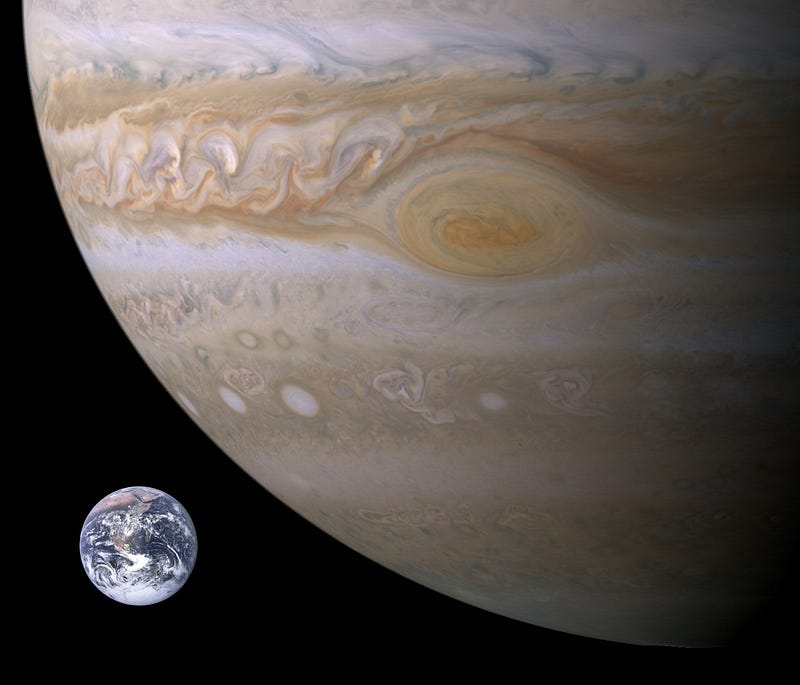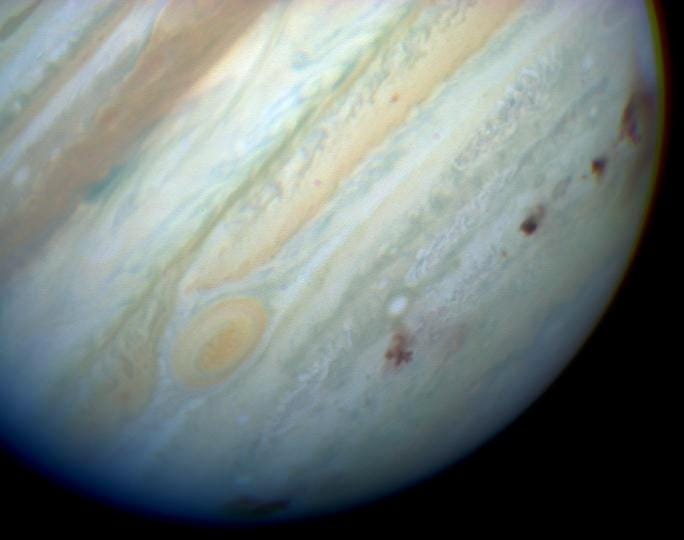Ask Ethan: Why is Jupiter hit by so many objects in space?

And could what we see over there spell disaster for Earth?
“An asteroid or a supervolcano could certainly destroy us, but we also face risks the dinosaurs never saw: An engineered virus, nuclear war, inadvertent creation of a micro black hole, or some as-yet-unknown technology could spell the end of us.” –Elon Musk
One of the most fascinating and yet terrifying events to occur on Earth is when an asteroid or comet fragment strikes us. Strikes like the one over Chelyabinsk, Russia, just a few years ago are quite common; we’ll see many objects of that size strike the Earth over our lifetimes. Rarer, more deadly strikes like the Tunguska event, the strike that created Meteor Crater or even the catastrophic one from 65 million years ago that caused our last great mass extinction still occur, and their impacts on Earth are still measurable today. But it’s nothing compared to what Jupiter goes through. Why is that? Dominic Turpin wants to know, as he asks:
Is Jupiter hit by so many celestial objects because of its gravity or because it is just too big to miss?

We all got a not-very-subtle reminder of this just a few weeks ago, when — on March 17th, 2016 — amateur astronomers Gerrit Kernbauer (above) and John Mckeon (below) just happened to be observing and taking imaging data of our Solar System’s largest world when a surprising “flash” appeared at the limb of the gas giant.
The only thing that’s known that can produce flashes like this are impact events, and we’ve observed a large number in recent years on Jupiter, thanks mostly to the efforts of amateur astronomers who enjoy gazing at it even while there are no professional telescopes watching. Amateurs are responsible for spotting a large number of impacts over the past few years, including:

- In June of 1994, comet Shoemaker-Levy 9 broke apart and collided with Jupiter, an event that had been predicted over a year in advance thanks to our understanding of gravity. This collision darkened the surface of Jupiter for months, and the original comet, before fragmenting was likely ~5 km in diameter.

- In July of 2009, a black spot the size of Earth was discovered on Jupiter by amateur astronomer Anthony Wesley: likely the result of a 0.2–0.5 km asteroid strike. Follow-up observations by the Hubble Space Telescope (in the optical, above) and Keck (in the infrared, below) show that thousands of times the energy of the Tunguska event was released in the collision.

- In June of 2010, another strike was observed — this one in real-time — also by Anthony Wesley and by Christopher Go in the Philippines. The flash lasted only two seconds, corresponding to a mass of about 500–2000 tonnes and a size of about 8–13 meters. Jupiter likely gets hit by several objects of this size every year, according to Gemini Observatory.

- A few months later, in August of 2010, there was another impact on Jupiter (shown above), making a slightly smaller, lower-magnitude flash. It was discovered by another amateur: Masayuki Tachikawa in Japan.

- In September of 2012, Dan Petersen observed another “flash” on Jupiter, and this time George Hall had taken video of it (above), allowing scientists to determine that it was approximately the same size and magnitude of the August 2010 strike: smaller than 10 meters across.
- And finally, there’s the March 2016 event we just saw. This one has yet to be fully analyzed, but it also appears to be on the small side: 10–20 meters in diameter is most likely, rather than the 2009 or the 1994 events.
So why is this happening to Jupiter? Why such big, bright, frequent impacts, when even the larger ones we’ve seen on Earth since the dawn of humanity pale in comparison?

The first thing you’ll think about is size, no doubt. When we talk about the frequency of collisions in any system, the simplest estimate you can take is to multiply three things together:
- the speed of the objects (comets, asteroids, meteors, etc.) in question,
- the number density of the objects that can potentially interact,
- and the cross-section of what they might hit.
The speeds are almost exactly the same for comets and asteroids that pass by Jupiter as the ones that pass by Earth, and the number density is approximately the same too, although there’s a slight advantage to Jupiter there, due to its closer proximity to the asteroid belt. But the cross-sections are hugely different: Jupiter has approximately 11.2 times the diameter of Earth, meaning it has about 125 times the cross-section.

Yet the frequency of large impacts isn’t even close to being explained by that. The 2009 impact on Jupiter came from an object larger than the one that made Meteor Crater in Arizona, and those strikes are estimated to occur on Earth only once every 30,000–100,000 years. Yet the fact that we saw a collision of this magnitude on Jupiter less than a decade ago — and that we saw the Shoemaker-Levy event just 15 years before that — leads us to consider another uncomfortable fact: if Earth were hit by these large objects as frequently (for its size) as Jupiter appears to be, we’d not only see Meteor Crater-sized strikes ten-to-one hundred times as frequently, but we’d have extinction-level events thousands of times as often!

The “dinosaur-killing” asteroid was a 5–10 km-wide strike on Earth, occurring 65 million years ago. On the other hand, Shoemaker-Levy 9 struck Jupiter in 1994, and was that magnitude in size. Did we literally just happen to see a once-in-500,000 year event in 1994? Highly unlikely.
Instead, consider the other aspect of Jupiter: its gravity. Planets don’t just exist in space and wait for things to run into them; they deform the fabric of spacetime itself in a fashion that’s directly proportional to their mass. The more massive a planet, the greater the gravitational attraction it exerts on all the surrounding and passing masses.

Earth’s gravitational field… well, it’s kind of a weakling. If an object passes near us moving slowly — say less than 10 km/s relative to us — we can do an excellent job of attracting it close to us. But asteroids typically move at 17 km/s or more relative to us, while comets move in excess of 50 km/s. In other words, our gravitational field doesn’t do a whole lot to help us out.
But Jupiter is 317 times as massive, and even with its huge radius, Jupiter does an excellent job of attracting objects to it that move with speeds under about 50 km/s relative to it. In other words, almost everything that comes into its neighborhood.

Yes, Jupiter is bigger than Earth, and that enhanced size accounts for a little over a factor of 100 in collision frequencies. But realistically, collisions on Jupiter are far more frequent because Jupiter’s gravitational pull is sufficient to attract huge numbers of comets and asteroids that come too close to it, in a way that Earth cannot. It’s a combination of gravity and the fact that objects farther from the Sun — even fast-moving comets — have slower velocities, and make themselves easier to capture.
Size does matter, but not as much as gravity does. In particular, not as much as gravity does relative to the speeds that objects near this gas giant move at. The only object in the Solar System better at capturing asteroids and comets is the Sun, but Jupiter does a great job at #2! The leading model was that it protected the inner Solar System from asteroid strikes, but that turns out not to be the case, apparently. It’s just a good punching bag. For the rest of it? We’re on our own.
Have a question for Ask Ethan? Ask it at startswithabang at gmail dot com!
This post first appeared at Forbes. Leave your comments on our forum, check out our first book: Beyond The Galaxy, and support our Patreon campaign!





